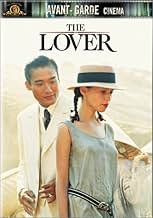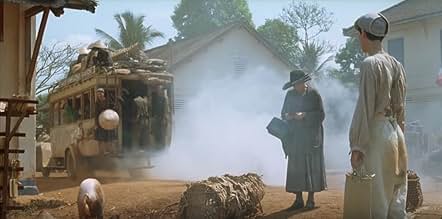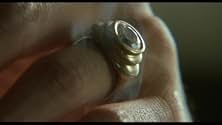1929 फ्रांसीसी इंडोचाइना में, एक फ्रांसीसी किशोर लड़की एक धनी, वृद्ध चीनी व्यक्ति के साथ एक निषिद्ध रोमांस शुरू करती है, प्रत्येक यह जानते हुए कि उनके संबंध का ज्ञान एक दूसरे के लिए कठोर परि... सभी पढ़ें1929 फ्रांसीसी इंडोचाइना में, एक फ्रांसीसी किशोर लड़की एक धनी, वृद्ध चीनी व्यक्ति के साथ एक निषिद्ध रोमांस शुरू करती है, प्रत्येक यह जानते हुए कि उनके संबंध का ज्ञान एक दूसरे के लिए कठोर परिणाम लाएगा.1929 फ्रांसीसी इंडोचाइना में, एक फ्रांसीसी किशोर लड़की एक धनी, वृद्ध चीनी व्यक्ति के साथ एक निषिद्ध रोमांस शुरू करती है, प्रत्येक यह जानते हुए कि उनके संबंध का ज्ञान एक दूसरे के लिए कठोर परिणाम लाएगा.
- निर्देशक
- लेखक
- स्टार
- 1 ऑस्कर के लिए नामांकित
- 3 जीत और कुल 7 नामांकन
- The Chinaman
- (as Tony Leung)
- Narrator
- (वॉइस)
- Liner Pianist
- (बिना क्रेडिट के)
- Femme
- (बिना क्रेडिट के)
फ़ीचर्ड समीक्षाएं
One thing that really impresses me is how one image will stick in your mind. One image around which it seems the whole rest of the project revolves and supports. I usually write IMDb comments very soon after seeing or reseeing a film.
In this case, I was so struck by that one image I resolved to wait three months before commenting. It stuck.
That image is the one which is used in the promotion and presumably is what the filmmaker considers its essence: the 15 year old girl in defiantly non-school clothes with an incongruous man's hat on the ferry. She is observing and consciously observed. It is we who observe her and enjoy her sensuality then and later just as the Chinese observer does. He is our surrogate, defining the strange situation of a being in the wrong place: Chinese being then more of a 'minority' in Vietnam than Europeans.
Exotic ordinariness. Emerging awarenesses as justification for being. No, more: revelling in existence. Transition as destination.
It is odd how charged this one image is, and how competently it justifies the whole project. Just as the lover is left puzzling why, so are we. So are we, and the fact that no easy answer appears is why this sticks so.
Ted's Evaluation -- 3 of 3: Worth watching.
I see here that the main objections to this film are: 1 .. Not enough character development 2 .. The film does not have a clear direction to where it's going 3 .. Too slow 4 .. Too much sex (for some people if a film has explicit sex it can't be good)
All these objections are pointless:
1 .. The characters here are ordinary people, not that interesting by themselves. It's the love story that's interesting. Both of them know they have no future and try to pretend it's not love. I am sick of films in which the characters are sure they love each other after 30 minutes of "character development".
2 .. The fact that this film does not follow a clear path it's one of it's qualities. It adds more drama and the characters themselves are confused and don't know where they're going. The whole film plays like a dream of love and to request "clear direction" it's pointless.
3 .. Ahh! The "too slow" argument. There are films in this world that make you think about you, your life and the world that's around you. Surely you need some TIME to reflect on that. Short attention-span is a bad thing :).
4 .. This film is about love. The fact that they are shown having sex makes them real persons, with real bodies not some film characters. Sex is an escape from the world around them and I don't think it's too much, too explicit or some nonsense like that. It's so hard to have a film with sex it it that's not trivial! This is a masterpiece by this fact alone.
The persons who "though up" these arguments took the main strengths of the film and complained about them. This for me it's proof enough that they didn't understand this film or that the film didn't struck a single chord in their soul. Short attention span is the main plague of films now and the lack of it is the reason the french make such great films! Please try to see it again and not in a hurry. It's not light cinema! It's great cinema!
Yes, it involves relatively graphic and prolonged sexual scenes, but it's not a sexploitation movie. The Lover is based on a bestselling autobiographical story of Marguerite Duras (1984 Prix Goncourt), a well-established name in both cinema and literature who have also wrote Hiroshima Mon Amour (1959).
Although critics never loved the film, not very prudent viewer should appreciate nice cinematography, quality setting and realistic, easy to follow story played by very nice actors who look good both dressed and undressed. It's not a groundbreaking movie by all means, but there's so much more in it than people who label it with softcore or erotic can find: family trauma, living in a foreign culture, how traditions are shaping the future and how love could be cruel. It's not a movie about love, rather about the search to understand what love is when you are young and daring.
This is a solid example of the sub-genre of exotic erotica. It's got beautiful naked people but it's not quite overt softcore porn. It's more cinematic than the classic Emmanuelle or other pornographic B-movies. The exotic locations look beautiful. It is visually stunning. The acting is competent. These are actual actors. On the other hand, the story is paper thin. The plot isn't much to talk about but that may be besides the point.
A poor French teenager from a dysfunctional family is leaning over the railing on a barge sweating through southeast Asia. A meticulously groomed Chinese man in a three piece white suit is staring at her, telegraphing that if this isn't, for him, love at first sight, it is at least his obsession for the next two hours of film time. He, gingerly, aflutter in a stereotypically feminine way, approaches. She is blase, rock hard. He offers her a ride. In the back of his chauffered limousine, they sit in opposite corners. While he is looking out the window, inch by inch, his hand moves toward hers. With contact, she looks even more bored, even more blase. By the time he gets her to her school, her head is thrown back, and his hand is in her lap.
The actress playing the teenager looks, in various shots, to be anywhere from a naive and buglike fifteen to a jaded twenty three. Since much of the rest of hte movie is devoted to full body nudity and graphic scenes of sexual intercourse, her youth, both as an actress and as a character, was an issue when the film was first released. I didn't see it for that reason. I was convinced it was exploitation of men's fantasies of making it with a child.
But the film didn't feel that way to me at all. To me, it seemed to capture really well the un self conscious power and ammoral curiosity a teenage girl experiencing her sexuality for the first time can experience. I was grateful for that. I've never seen anything else like it on film. It's so rare that a woman is allowed to f*** and not fall in love, to retain a curious, animal look even during orgasm.
The sex scenes talked to me. They communicated as much as the scant dialogue the personalites, desires, strengths, weaknesses, of the characters.
This would have been a very different movie -- a much shorter and grimmer one -- had the man, the "Lover" of the title, been anything other than what he was. He was not a rapacious, exploitative beast. He was, rather, a romantic. Confused, worshipful, easily hurt. Chinese in a time and place when being Chinese made him less than she in some way, in spite of his relative wealth and her poverty. Vulnerable, because he was so in thrall to her, and she was merely curious about him, and hungry for physical pleasure.
Many scenes in the movie spoke to me loudly about race, power, sick family systems, money, sex. I don't want to describe them for fear of spoiling this movie for anyone else. But I'll mention -- the scene where he takes her ratty family out to dinner, their disdain for his race, his effort to not reveal that he is insulted, and how he deals with his pain once he gets her alone. His wedding. Her waiting for him; his never coming. Her resonse to the pianist playing Chopin on the ocean liner.
"The Lover" -- thumbs up.
क्या आपको पता है
- ट्रिवियाThe film is based on the autobiographical novel by French author Marguerite Duras, whose real-life romance with a Chinese man in colonial Vietnam caused a scandal.
- गूफ़Her lover smokes filtered cigarettes in 1929. They were not invented until the mid-'30s and not in common use until the 1950s.
- भाव
[last lines]
Narrator: Years after the war, after the marriages, the children, the divorces, the books, he had come to Paris with his wife. He had phoned her. He was intimidated; his voice trembled, and with the trembling it had found the accent of China again. He knew she'd begun writing books. He had also heard about the younger brother's death. He had been sad for her. And then he had no more to tell her. And then he told her - he had told her that it was as before, that he still loved her, that he would never stop loving her, that he would love her until his death.
- क्रेज़ी क्रेडिटThe opening credits are shown against a backdrop of what is presumably the author, Marguerite Duras, writing down her story.
- इसके अलावा अन्य वर्जनAvailable on video in two versions: the 103 min. R-rated cut and a much more explicit 115 min. unrated cut.
- कनेक्शनFeatured in The Making of 'The Lover' (1991)
टॉप पसंद
- How long is The Lover?Alexa द्वारा संचालित
विवरण
बॉक्स ऑफ़िस
- US और कनाडा में सकल
- $48,99,194
- US और कनाडा में पहले सप्ताह में कुल कमाई
- $1,81,147
- 1 नव॰ 1992
- दुनिया भर में सकल
- $50,13,090
- चलने की अवधि1 घंटा 55 मिनट
- रंग
- ध्वनि मिश्रण
- पक्ष अनुपात
- 1.85 : 1
इस पेज में योगदान दें































